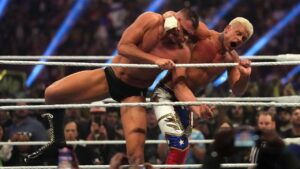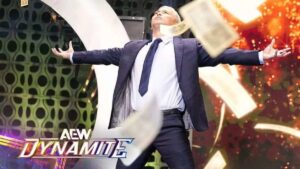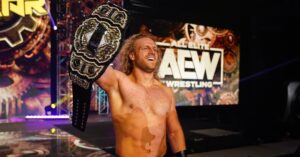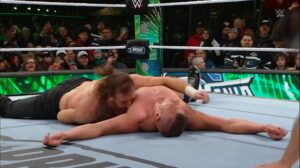VICE‘s documentary series, Dark Side of the Ring, is several episodes into its second season, and the series has really found its groove with the second run. The first season was captivating and well done, but in its second set, it upped its game with powerful episodes on Chris Benoit, “Superfly” Jimmy Snuka, and New Jack. On Tuesday, Dark Side of the Ring is poised to look at one of the most shocking pro wrestling deaths to come out of the Rock N’ Wrestling Era of the 1980s, when Canadian veteran and recently retired WWF Superstar Dino Bravo was executed in a mob-style hit.
The story of Dino Bravo began in the wrestling scene of Montreal, Quebec, Canada, and actually has its roots before the man the world would come to recognize as Dino Bravo ever laced up his first pair of wrestling boots. In the early 1950s, an Italian-born wrestler named Dino Bravo – his real name – from Windsor, Ontario, Canada was working in various National Wrestling Alliance (NWA) territories. By the early 1960s, Montreal promoter Jack Britton paired him with a young prospect named Domenic DeNucci and, renaming DeNucci as Domenic Bravo, paired the two as the Bravo Brothers. The Bravo Brothers would continue to work the NWA circuits, including in Canada with Stu Hart‘s Big Time Wrestling (later Stampede Wrestling) and Frank Tunney‘s Maple Leaf Wrestling. But by 1962, the wrestling lifestyle was no longer Bravo’s dream and he retired from the ring, going on to open a long and prosperous cement contracting company in his hometown of Windsor. But the name “Dino Bravo” was such a perfect wrestling name, that Jack Britton kept it in the back of his mind.

Britton – who was actually Italian in heritage and had changed his name in the 1930s as a wrestler in the Boston area – was no longer competing in the ring, but his son, billed as Gino Brito, had become a top star in the Montreal wrestling circuit in the 1960s. In 1970, Brito discovered a new prospect for his father’s promotion in another Italian-born immigrant to the French-Canadian city in Adolfo Bresciano. Brito took Bresciano under his wing and began training him in 1970 and in 1972, determined to find a new ring name for the athletic young man, Brito’s father Jack Britton contacted Dino Bravo about using his name. “I said, ‘Yeah, go ahead.’ See, I made it easy for the dirty bugger because Bravo, the name was known, especially with the team Bravo Brothers,” the original Dino Bravo told Canoe Sports in 2011. “That opened the doors for him easily. He didn’t have to go through the hard times like I did to get myself established. Anyway, Jack Britton asked me, and I said, ‘Yeah, go ahead.’ I knew I was out of it.”

Now minted the new Dino Bravo, he was paired with his mentor, Gino Brito, in a new tag team. The duo continued to work in the Canadian wrestling circuit, finding great success in their hometown of Montreal with the Vachon brothers (Paul & Maurice Vachon)’s Grand Prix Wrestling, capturing the Grand Prix Tag Team titles twice in the early 1970s. By 1974, Bravo was starting to expand into the NWA territories in the United States, particularly on the West Coast with NWA Hollywood, where he won the NWA Americas Tag Team titles with Victor Rivera. Rivera was a longtime worker with Vince McMahon Sr.‘s World Wide Wrestling Federation (WWWF) out of New York, where the Puerto Rican star was a frequent tag partner of Pedro Morales. Shortly after Rivera and Bravo lost the NWA Americas’ titles, Rivera would win the WWWF World Tag Team titles alongside Domenic DeNucci (the original Bravo’s former tag partner).

By 1975, Dino Bravo had become a regular worker in the NWA territories of the United States, competing with Georgia Championship Wrestling and Championship Wrestling From Florida. He also briefly worked for a new promotion, International Wrestling Association (IWA), out of Ohio that had bold desires to become a new national promotion like WWF ended up becoming years later. While he was becoming a burgeoning star in the US territories, his stock was significantly higher in his native Canada, especially in the Montreal scene.

In 1976, he would become a regular star with Jim Crockett in the NWA Mid-Atlantic Championship Wrestling territory, where he was once again part of the tag team division. He was paired with “Mr. Wrestling” Tim Woods, and found his first major success, capturing the NWA World Tag Team titles in the spring of ’76. By the end of the year, the duo would also capture the NWA Mid-Atlantic Tag Team titles. In 1977, he began to work in more singles programs, including a lengthy feud with Blackjack Mulligan over the NWA United States Championship and even faced Harley Race in battles for the NWA World’s Heavyweight title. But his real bread and butter was still the tag team scene – he would win his second NWA Mid-Atlantic Tag Team titles with Tiger Conway Jr. in April of 1977.

In 1978, he finally made the jump to McMahon Sr.’s WWWF, where he joined Domenic DeNucci as his new protege, in a somewhat rehashing of a new Bravo Brothers (although Domenic kept his DeNucci last name this time around). The pairing was an instant success, and only months into their debut together, they defeated Mr. Fuji & Professor Tanaka to win the WWWF World Tag Team titles. They held the belts for 104-days and Bravo was also seeing time as a singles competitor, picking up wins over the likes of Johnny Rodz, Paul “Butcher” Vachon, Luke Graham, and former WWWF World Champion Stan Stasiak. But his run with New York lasted but a year, and by the beginning of 1979, he had left the company.
He returned to Mid-Atlantic in 1979 and picked up his singles career, feuding with Ric Flair over the NWA United States title and Ken Patera and the NWA Mid-Atlantic Heavyweight Championship, but singles gold continued to elude the multi-time tag team champion. By the fall of 1979, Bravo decided for a change of scenery, departing the NWA territories and heading to Verne Gagne‘s American Wrestling Association (AWA). He would frequently tag with Gagne’s son, Greg Gagne or Tito Santana, and in single’s action would find himself facing top stars like “Crusher” Jerry Blackwell, Adrian Adonis, Jesse “The Body” Ventura, and even the AWA World Champion, Nick Bockwinkel. He would continue to work with the AWA until 1985.
In 1981, Dino Bravo would make his debut in Japan with New Japan Pro Wrestling (NJPW), touring with the company throughout the fall with the likes of other gaijin like Hulk Hogan, Abdullah the Butcher, Stan Hansen, and Dick Murdoch. In 1982, he would return again for the MSG Tag Team League (which has undergone multiple name changes until the current World Tag League was adopted in 2012), where he entered the tournament as the tag partner of Adrian Adonis. Despite the previous success of Bravo and his partner in other tag teams in the US prior, the duo faired poorly in the MSG Tag Team League, after being placed in a block that featured 1981 winners Andre the Giant & Rene Goulet and eventual 1982 winners, Antonio Inoki & Hulk Hogan.
https://www.youtube.com/watch?v=8EXX3EwKGAM
Despite his accolades as strong and technical athlete, who had challenged the likes of Harley Race, Ric Flair, Nick Bockwinkel, and other greats in championship matches, singles success in the form of winning gold continued to elude the Montreal native. But in 1978, the NWA decreed the formation of the NWA Canadian Heavyweight Championship, which would become the top title for the Tunneys in Toronto with Maple Leaf Wrestling. Dino Bravo defeated former NWA World’s Heavyweight Champion Gene Kiniski in December of 1978 to become the inaugural NWA Canadian champion and would win the title a second time, from Greg “The Hammer” Valentine, in June of 1979.
https://www.youtube.com/watch?v=p8OjGcWzOHg
In 1980, he would also become a major star for Varoussac Promotions, a new promotion started by his mentor, Gino Brito, alongside Andre the Giant and Frank Valois. In the company’s inaugural year of operation, he would win his first International Heavyweight Championship and when Andre the Giant signed exclusively with Vince McMahon Jr.‘s WWF in 1983, Bravo bought out Andre’s shares in the company, becoming a promoter in the process (the company was re-branded as International Wrestling). Bravo would end up a 7x International Heavyweight Champion during the companies seven-year run before the company was ultimately purchased and absorbed by the WWF.
Bravo had returned to the WWF in 1985, where he debuted as the Canadian International Heavyweight Champion (playing off his then 6th reign as Champion in International Wrestling). But while he was promoted as the Canadian champion, he still found himself being primarily used in tag team action, paired alongside another recruit from International Wrestling, King Tonga (who would go on to become Haku and later Meng in WCW). But just as it seemed his star was on the rise, politics would come in to play. In early 1986, Dino Bravo was scheduled to face WWF World Champion Hulk Hogan in his native Montreal, but fearing that the hometown crowd may cheer Bravo over Hogan, the match was nixed. Upon finding out, Bravo was furious and quit the company.
The sour grapes wouldn’t last long and by October of 1986, he had returned to the company but it wasn’t the same Dino Bravo that fans had come to know since his early days of the 1970s. Gone was the brown hair, now replaced by bleach blonde hair more reminiscent of Ric Flair. While he always had a muscular physique, he was now considerably bigger, resembling more of a powerlifter than a pro wrestler. Even his in-ring style changed, gone from the more technical aspects that had worked for so long, replaced by power moves and brawling. He returned as a new signee by “Luscious” Johnny Valiant, adding him to his list of clients that also featured former WWF World Tag Team Champions The Dream Team (Greg “The Hammer” Valentine & Brutus Beefcake).

At WrestleMania III in Detroit, when The Dream Team won their match against the Rougeau Brothers, but not without its drama. Beefcake & Valentine had been arguing for most of the match and after Bravo helped Valentine secure the victory, they beat down Beefcake post-match, kicking him from the group. Bravo would partner with Valentine for the rest of 1987 as the New Dream Team, but the group found little success. By the end of the year, the Dream Team was over, with Bravo now fully embracing his Quebecois heritage and taking Frenchy Martin as his new manager.

The partnership of Bravo and Martin would continue through to 1989, and “Canada’s Strongest Man” would find himself in multiple short feuds with the likes of Hillbilly Jim, Ken Patera, “Hacksaw” Jim Duggan, Jim “The Anvil” Neidhart, and Bret “Hitman” Hart. In 1988, he would challenge WWF World Champion “Macho Man” Randy Savage on multiple occasions but always came up short. By the end of 1989, he left Frenchy Martin to join Jimmy Hart‘s consortium. His first feud allied with Jimmy Hart was against WWF Intercontinental Champion The Ultimate Warrior, but “Canada’s Strongest Man” was no match for the Ultimate maniac. The two continued to feud on house shows, even into 1990 following Warrior’s WWF World title win over Hulk Hogan.
Par for his career, 1990 saw Dino Bravo return to tag team action, paired up with Earthquake, one of Jimmy Hart’s more recent signings, and for much of 1990, Bravo saw his singles push begin to diminish. By 1991, Bravo was mostly used in tag team action (still with Earthquake) on WWF television, with his last big singles match being a loss to “The Texas Tornado” Kerry Von Erich at WrestleMania VII. Earthquake was beginning to pick up his own steam, feuding with the likes of Hulk Hogan and Jake “The Snake” Roberts, and soon Bravo as once again on his own. Reduced to house shows, Dino Bravo left the WWF in the spring of 1992, and abruptly retired from pro wrestling after a 22-year career. He would return to his beloved Montreal, Quebec, where he would continue to train young wrestlers until his brutal murder a year later.

Dino Bravo is often best remembered for his bleach blonde persona during the 1980s in WWF, but it’s oft-forgotten his extensive career prior, where he showed so much more promise as an actual wrestler inside of simply being a strongman. And sadly, the violent end of Adolfo Bresciano in a mob-style execution on March 10, 1993 will forever be his final chapter, as we’ll see on Tuesday’s next episode of Dark Side of the Ring.
Stay tuned to the Last Word on Pro Wrestling for more on this and other stories from around the world of wrestling, as they develop. You can always count on LWOPW to be on top of the major news in the wrestling world, as well as to provide you with analysis, previews, videos, interviews, and editorials on the wrestling world.






